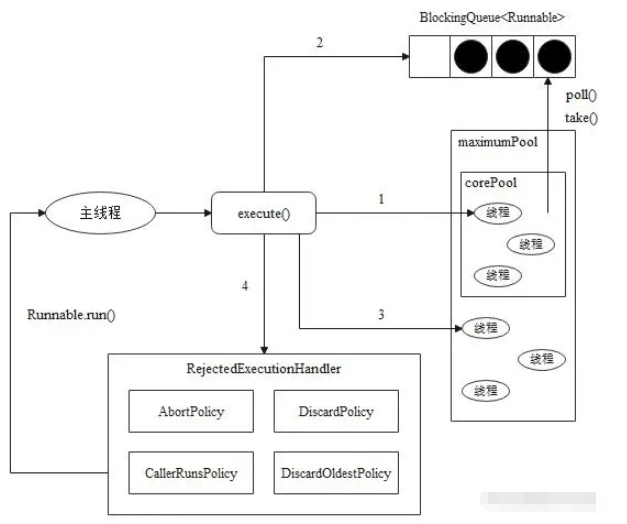java并发ThreadPoolExecutor如何使用
导读:本文共7054字符,通常情况下阅读需要24分钟。同时您也可以点击右侧朗读,来听本文内容。按键盘←(左) →(右) 方向键可以翻页。
摘要: 一. 线程池的简单原理当一个任务提交到线程池ThreadPoolExecutor时,该任务的执行如下图所示。如果当前运行的线程数小于corePoolSzie(核心线程数),则创建新线程来执行任务(需要获取全局锁);如果当前运行的线程数等于或大于corePoolSzie,则将任务加入BlockingQueue(任务阻塞队列);如果BlockingQueue已满,则... ...
目录
(为您整理了一些要点),点击可以直达。一. 线程池的简单原理
当一个任务提交到线程池ThreadPoolExecutor时,该任务的执行如下图所示。

如果当前运行的线程数小于corePoolSzie(核心线程数),则创建新线程来执行任务(需要获取全局锁);
如果当前运行的线程数等于或大于corePoolSzie,则将任务加入BlockingQueue(任务阻塞队列);
如果BlockingQueue已满,则创建新的线程来执行任务(需要获取全局锁);
如果创建新线程会使当前线程数大于maximumPoolSize(最大线程数),则拒绝任务并调用RejectedExecutionHandler的rejectedExecution() 方法。
由于ThreadPoolExecutor存储工作线程使用的集合是HashSet,因此执行上述步骤1和步骤3时需要获取全局锁来保证线程安全,而获取全局锁会导致线程池性能瓶颈,因此通常情况下,线程池完成预热后(当前线程数大于等于corePoolSize),线程池的execute() 方法都是执行步骤2。
二. 线程池的创建
通过ThreadPoolExecutor能够创建一个线程池,ThreadPoolExecutor的构造函数签名如下。
publicThreadPoolExecutor(intcorePoolSize,intmaximumPoolSize,longkeepAliveTime,TimeUnitunit,BlockingQueue<Runnable>workQueue)publicThreadPoolExecutor(intcorePoolSize,intmaximumPoolSize,longkeepAliveTime,TimeUnitunit,BlockingQueue<Runnable>workQueue,ThreadFactorythreadFactory)publicThreadPoolExecutor(intcorePoolSize,intmaximumPoolSize,longkeepAliveTime,TimeUnitunit,BlockingQueue<Runnable>workQueue,RejectedExecutionHandlerhandler)publicThreadPoolExecutor(intcorePoolSize,intmaximumPoolSize,longkeepAliveTime,TimeUnitunit,BlockingQueue<Runnable>workQueue,ThreadFactorythreadFactory,RejectedExecutionHandlerhandler)
通过ThreadPoolExecutor创建线程池时,需要指定线程池的核心线程数,最大线程数,线程保活时间,线程保活时间单位和任务阻塞队列,并按需指定线程工厂和饱和拒绝策略,如果不指定线程工厂和饱和拒绝策略,则ThreadPoolExecutor会使用默认的线程工厂和饱和拒绝策略。下面分别介绍这些参数的含义。
三. 线程池执行任务
1. 执行无返回值任务
通过ThreadPoolExecutor的execute() 方法,能执行Runnable任务,示例如下。
publicclassThreadPoolExecutorTest{@TestpublicvoidThreadPoolExecutor执行简单无返回值任务()throwsException{//创建一个线程池ThreadPoolExecutorthreadPoolExecutor=newThreadPoolExecutor(2,4,60,TimeUnit.SECONDS,newArrayBlockingQueue<>(300));//创建两个任务RunnablefirstRunnable=newRunnable(){@Overridepublicvoidrun(){System.out.println("第一个任务执行");}};RunnablesecondRunnable=newRunnable(){@Overridepublicvoidrun(){System.out.println("第二个任务执行");}};//让线程池执行任务threadPoolExecutor.execute(firstRunnable);threadPoolExecutor.execute(secondRunnable);//让主线程睡眠1秒,等待线程池中的任务被执行完毕Thread.sleep(1000);}}运行测试程序,结果如下。

2. 执行有返回值任务
通过ThreadPoolExecutor的submit() 方法,能够执行Callable任务,通过submit() 方法返回的RunnableFuture能够拿到异步执行的结果。示例如下。
publicclassThreadPoolExecutorTest{@TestpublicvoidThreadPoolExecutor执行简单有返回值任务()throwsException{//创建一个线程池ThreadPoolExecutorthreadPoolExecutor=newThreadPoolExecutor(2,4,60,TimeUnit.SECONDS,newArrayBlockingQueue<>(300));//创建两个任务,任务执行完有返回值Callable<String>firstCallable=newCallable<String>(){@OverridepublicStringcall()throwsException{return"第一个任务返回值";}};Callable<String>secondCallable=newCallable<String>(){@OverridepublicStringcall()throwsException{return"第二个任务返回值";}};//让线程池执行任务Future<String>firstFuture=threadPoolExecutor.submit(firstCallable);Future<String>secondFuture=threadPoolExecutor.submit(secondCallable);//获取执行结果,拿不到结果会阻塞在get()方法上System.out.println(firstFuture.get());System.out.println(secondFuture.get());}}运行测试程序,结果如下。

3. 执行有返回值任务时抛出错误
如果ThreadPoolExecutor在执行Callable任务时,在Callable任务中抛出了异常并且没有捕获,那么这个异常是可以通过Future的get() 方法感知到的。示例如下。
publicclassThreadPoolExecutorTest{@TestpublicvoidThreadPoolExecutor执行简单有返回值任务时抛出错误(){//创建一个线程池ThreadPoolExecutorthreadPoolExecutor=newThreadPoolExecutor(2,4,60,TimeUnit.SECONDS,newArrayBlockingQueue<>(300));//创建一个任务,任务有返回值,但是执行过程中抛出异常Callable<String>exceptionCallable=newCallable<String>(){@OverridepublicStringcall()throwsException{thrownewRuntimeException("发生了异常");}};//让线程池执行任务Future<String>exceptionFuture=threadPoolExecutor.submit(exceptionCallable);try{System.out.println(exceptionFuture.get());}catch(Exceptione){System.out.println(e.getMessage());}}}运行测试程序,结果如下。

4. ThreadPoolExecutor通过submit方式执行Runnable
ThreadPoolExecutor可以通过submit() 方法来运行Runnable任务,并且还可以异步获取执行结果。示例如下。
publicclassThreadPoolExecutorTest{@TestpublicvoidThreadPoolExecutor通过submit的方式来提交并执行Runnable()throwsException{//创建一个线程池ThreadPoolExecutorthreadPoolExecutor=newThreadPoolExecutor(2,4,60,TimeUnit.SECONDS,newArrayBlockingQueue<>(300));//创建结果对象MyResultmyResult=newMyResult();//创建Runnable对象Runnablerunnable=newRunnable(){@Overridepublicvoidrun(){myResult.setResult("任务执行了");}};//通过ThreadPoolExecutor的submit()方法提交RunnableFuture<MyResult>resultFuture=threadPoolExecutor.submit(runnable,myResult);//获取执行结果MyResultfinalResult=resultFuture.get();//myResult和finalResult的地址实际相同Assert.assertEquals(myResult,finalResult);//打印执行结果System.out.println(resultFuture.get().getResult());}privatestaticclassMyResult{Stringresult;publicMyResult(){}publicMyResult(Stringresult){this.result=result;}publicStringgetResult(){returnresult;}publicvoidsetResult(Stringresult){this.result=result;}}}运行测试程序,结果如下。

实际上ThreadPoolExecutor的submit() 方法无论是提交Runnable任务还是Callable任务,都是将任务封装成了RunnableFuture接口的子类FutureTask,然后调用ThreadPoolExecutor的execute() 方法来执行FutureTask。
四. 关闭线程池
关闭线程池可以通过ThreadPoolExecutor的shutdown() 方法,但是shutdown() 方法不会去中断正在执行任务的线程,所以如果线程池里有Worker正在执行一个永远不会结束的任务,那么shutdown() 方法是无法关闭线程池的。示例如下。
publicclassThreadPoolExecutorTest{@Testpublicvoid通过shutdown关闭线程池(){//创建一个线程池ThreadPoolExecutorthreadPoolExecutor=newThreadPoolExecutor(2,4,60,TimeUnit.SECONDS,newArrayBlockingQueue<>(300));//创建Runnable对象Runnablerunnable=newRunnable(){@Overridepublicvoidrun(){while(!Thread.currentThread().isInterrupted()){LockSupport.parkNanos(1000*1000*1000);}System.out.println(Thread.currentThread().getName()+"被中断");}};//让线程池执行任务threadPoolExecutor.execute(runnable);threadPoolExecutor.execute(runnable);//调用shutdown方法关闭线程池threadPoolExecutor.shutdown();//等待3秒观察现象LockSupport.parkNanos(1000*1000*1000*3L);}}运行测试程序,会发现在主线程中等待3秒后,也没有得到预期的打印结果。如果上述测试程序中使用shutdownNow,则是可以得到预期打印结果的,示例如下。
publicclassThreadPoolExecutorTest{@Testpublicvoid通过shutdownNow关闭线程池(){//创建一个线程池ThreadPoolExecutorthreadPoolExecutor=newThreadPoolExecutor(2,4,60,TimeUnit.SECONDS,newArrayBlockingQueue<>(300));//创建Runnable对象Runnablerunnable=newRunnable(){@Overridepublicvoidrun(){while(!Thread.currentThread().isInterrupted()){LockSupport.parkNanos(1000*1000*1000);}System.out.println(Thread.currentThread().getName()+"被中断");}};//让线程池执行任务threadPoolExecutor.execute(runnable);threadPoolExecutor.execute(runnable);//调用shutdown方法关闭线程池threadPoolExecutor.shutdownNow();//等待3秒观察现象LockSupport.parkNanos(1000*1000*1000*3L);}}运行测试程序,打印如下。

因为测试程序中的任务是响应中断的,而ThreadPoolExecutor的shutdownNow() 方法会中断所有Worker,所以执行shutdownNow() 方法后,正在运行的任务会响应中断并结束运行,最终线程池关闭。
假如线程池中运行着一个永远不会结束的任务,且这个任务不响应中断,那么无论是shutdown() 方法还是shutdownNow() 方法,都是无法关闭线程池的。
</div> <div class="zixun-tj-product adv-bottom"></div> </div> </div> <div class="prve-next-news">java并发ThreadPoolExecutor如何使用的详细内容,希望对您有所帮助,信息来源于网络。